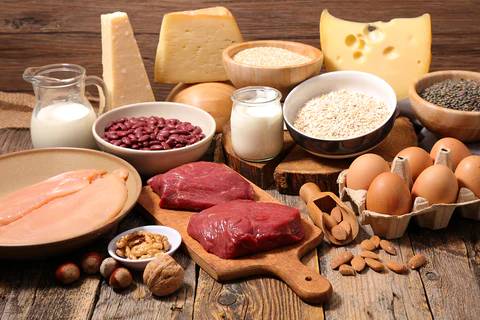Fact: Older adults are not consuming enough protein. According to a 2018 study conducted by Abbott and Ohio State university, about 40 percent of adults over the age of 50 are not consuming the minimum recommendation of protein.¹ These results coincide with multiple other studies regarding protein consumption statistics among different age groups.
The minimum recommendation for daily protein intake is about 0.8 grams per kilogram of body weight. Although this number can vary from person to person, it is important to understand why it is crucial to consume enough protein.

Protein in the Body
Proteins are made up of amino acids in different variations according to their specification. Consuming protein isn’t just for people exercising or looking to improve their body composition and/or performance. Here are some major roles proteins play in the body:
-
Build, maintain, and repair muscles, bones, hair, skin, and nails
-
Enzyme production for chemical reactions
-
Energy production, muscle contraction, digestion, etc.
-
Create hormones that act as messengers in the body
-
Maintains pH
-
Immunity
-
Fluid Balance
Without protein, the body simply would not be able to function properly. All the more reason to make sure your body is getting its minimum requirements, especially in older adults.
Aging
In our youth, our bodies grow and get stronger; until the age of 40 when our bodies begin to ‘deteriorate’ and break down more muscle then it builds. There are many variables and lifestyle habits that contribute to the rate of decline in the way people feel and perform. However, one way to help combat these effects is to consume a nutritious diet with plenty of protein. Ensuring optimal protein intake can help maintain lean muscle mass.² ³ Low muscle mass has been shown to correlate with declining functionality. In fact, multiple studies found that lean muscle mass was a strong predictor of longevity.⁴ ⁵
Performance and Recovery
Protein has multiple roles in the body that combine to enhance physical performance and recovery. Now, many think about sports when they hear ‘performance and recovery’; but if we look at the human body at both ends of the lifespan, we can find additional meaning. Performance, in terms of functional movement, is of major importance for muscle development (at youth) and maintenance (as we age). Furthermore, soreness can be our bodies’ response to learning a new movement or effort to maintain performance, signaling a need for recovery; both of which are aided through protein consumption.
Protein intake aids in muscle protein synthesis (MPS) which is the process in which muscle mass is built and repaired in the body. Naturally, MPS combats the effects of muscle protein breakdown (MPB) caused by exercise and aging.⁶ For example, think of a crack forming in the wall of a building due to age or wear and tear. This ‘crack’ is the damage (micro tear) or normal breakdown occurring in a muscle during exercise or aging. The crack reduces the strength and integrity, causing breakage of the wall unless filled and repaired. Muscle breakdown is similar, in that protein intake and MPS repair reinforce the muscle to allow it to perform at an optimal level. Therefore, getting your specific minimum protein requirement is necessary to maintain optimal functionality, as well as to enhance daily and sport performance.

How much do we need?
Many variables factor into the quantity of protein for each person specifically. To keep it simple, we will stick to the general recommendations among different activity levels that are accounted for when nutrition professionals assess and prescribe a client their personal nutrition plans. The general guidelines below are based on multiple accredited organizations and their guidelines for nutrition prescription based on body composition, activity level, and goal.⁷ ⁸
-
Sedentary - 0.8 - 1.2 grams per kilogram of body weight
-
Active (overweight/obese) - 1.2 - 1.6 grams per kilogram of bodyweight
-
Active - 1.6 -2.0 grams per kilogram of bodyweight
-
Endurance trained athletes
-
Highly active (healthy) - 1.6 - 3.3 grams per kilogram of bodyweight*
-
Strength trained athletes
*Dependent on maintaining weight, gender, and goal body composition change
Types of Protein

Variety is almost always a positive regarding nutrition and diet. There are many sources that can help contribute to daily protein needs no matter an individual’s dietary or cultural restrictions, allergies, intolerances, or preference. Having so many options to choose from is not only beneficial for the sake of ‘getting tired’ of the same protein source, but also can be a useful tool regarding nutrient timing. Nutrient timing is the strategic intake of certain foods and nutrients to increase performance and maximize results. This strategy is normally unnecessary in the average diet, however understanding the different types of protein and how they digest in the body may be useful when choosing a protein supplement or training at an advanced/elite level. Below is a basic overview of protein digestion/utilization timing, uses, and types of common protein supplements on the market.
-
Casein
-
Slow digesting**
-
Milk-based
-
Prolonged satiation
-
Egg/Egg White
-
Medium digesting protein***
-
Animal-based
-
Whey
-
Fast digesting protein****
-
Milk-based
-
Easy to digest
-
Soluble in most liquids
-
Medium digesting protein***
-
Hair, skin, nails, and joint health
-
Hemp, soy, rice, pea, quinoa
-
Medium digesting protein***
-
Plant-based
-
With the exception of soy, plant proteins need to be a blend in order to be a complete protein
**digests and utilized over 4 or more hours and primarily used before bed
***digests and utilized over 3-4 hours and primarily used post workout, between meals, or in the morning
****digests and utilized over 1-2 hours and primarily used around workouts or in the morning
Each protein source has its own benefits, uses, and amino acid profile that separate it from the rest. That being said, it is important to have variety in your protein intake, especially if your diet restricts animal products. Many plant-based proteins are ‘incomplete’ proteins, meaning they do not supply all 9 essential amino acids by themselves. In order to make these protein sources ‘complete’ they must be blended with other plant-based protein sources to include all the essential amino acids -- necessary amino acids not naturally found or produced in the human body.

Takeaway
Protein plays an important role in almost every bodily function and is the main nutrient needed to build, repair, and maintain lean muscle tissue. Older adults, athletes, and growing adolescents have the highest risks from protein malnutrition; however everyone should make it a point to ensure they are receiving adequate amounts of daily protein. Some ways to help people understand their protein requirements and how to increase their daily protein intake is through tracking apps and guidelines provided by various nutrition organizations. Protein supplements are also great ways to meet daily goals for individuals with low appetite and busy schedules. Supplementation can significantly combat malnutrition by providing a small, convenient, and protein packed snack when access to a meal is not an option. It isn’t important to worry about nutrient timing, variability, and tracking every little gram of food you eat. What’s important is that you fuel your body and stay healthy!


